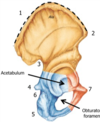Week 6 Flashcards
(152 cards)
How does thyroid hormones affect GI motility?
- increases
- appetite adn food intake
- rates of digestive juices
- motility
- Hyper: increases bowl movements
- Hypo: constipation
How do the adrenal glands maintain homeostasis?
- regulate body’s adaptive response to stress (cortisol)
- regulate body water, sodium and potassium balance and metabolism (aldosterone)
- control blood pressure
What is the vaginal fornix?
- recess around cervix
- has anterior, posterior and lateral parts
- posterior is the deepest
What are the main functions of glucocorticoids?
- ^ metabolism of proteins, carbs, and fats
- ^ blood glucose
- nearly all tissues have glucocorticoid receptors
- important in resisting stress and inflammation
How does calcitriol work?
- formed from 7-dehydrocholesterol
- final activation occurs in kidneys
- Bone: increase Ca2+ and Pi mobilization, stimulates osteoblasts and indirectly osteoclast
- Kidneys: decrease both phosphate and Ca2+
- Intestine: increase Ca2+ absorbtion by upregulating calbindin
How does Thyroid hormones effect carbohydrate metabolism?
- increases the rapid uptake of glucose
What are the common causes of primary hyperthyroidism?
- Graves disease
- hyperfunctioning thyroid nodules
- therapy induced hyperthyroidism
- thyroiditis (inflammation)
What is congenital adrenal hyperplasia?
- Cause:
- autosomal receissive disorder leading to deficient production of cortisol and aldosterone
- excessive production of sex steroids
- 95% of cases due to 21-hydroxylase defiency
- severe deficiency: life treatening vomiting and dehydration in first weeks of life. Ambigious genitalia of gentically female infants
- moderate: prepubertal virilization
- mild: infertility in women
How does TSH affect cellular metabolic activity?
- increase
- number, size, and activity of mito to increase ATP formation
- Na+/K+ ATPase activity
- synthesis of metabolic proteins
- everything increases O2 consumption and BMR
Osteogenesis imperfecta
- bone disorder
- decreased osteoid
What are the properties of the thyroid hormone receptors?
- TRs have much higher affinity for T3
- TRs are nuclear receptors
- ligand activated transcription factors
- bind to enhance elements on DNA to produce new proteins
What are the structural properties of Vitamin D?
- secosteroid
- Open B ring
- 27 carbons
What factors are involved in Thyroid hormone synthesis?
- TSH
- Thyroglobulin
- Iodine
- Membrane transporters
- Enzymes
What is thyroid hormone metabolism of T3 and T4?
- 40% of secreted T4 are converted to T3
- T3 is mainly used by tissues
- Main source of T3 is the deiodination of T4
How is calcium transported in the epithelial cell in the intestine?
- Calcium passive transporter on the lumenal side
- once in the cell, immediately bound to calbindin
- Calbindin upregulated by Vit D
- Ca2+ will disassociate and exit through Na antiporter
What are the 3 types of plasma proteins that thyroid hormones bind to?
- Thyroxine bidning globulin (TBG) 70%
- Transthyretin (prealbumin) 15%
- Albumin 15%
What occurs during stage 4 of biosynthesis of thyroid hormones?
- Endocytosis of thyroglobulin
- Lysosomes fuse wiht pinocytotic vesicles
- proteases mix with colloid to digest thyroglobulin
- T3 and T4 released and diffuse into bloodstream and can bind to TBG
What intermediate do all steroid hormones go through?
- Cytochrome p450 makes pregnenolone (C21 intermediate)
- cleavage of 6 carbons from side chain of cholesterol
- additional enzymes will make the steroid hormones
What occurs in Graves disease?
- thyroid stimulating immunoglobulins TGIs (antibodies) form against TSH receptor in thyroid gland
- Stimulates the receptor to release T3/4
- Develop goiter
- Low levels of TSH
- Graves ophthamopathy
- mexedema
What is the main function of adrenal medullary hormones?
- makes rapid, short term adjustments to actual or threatened changes in external or internal environment
- fight or flight
- actions are supported by glucocorticoids
What are the structural properties of the seminal glands?
- Between the fundus of bladder and rectum
- covered with peritoneum superiorly but seperated from rectum by rectovesical pouch
- contributes to formation of ejaculatory duct
What are the three parts to the uterine wall?
- permetrium - serosa
- mymetrium - sm, contains main branches of blood vessels
- endometrium - inner mucous coat
What two muscles compress the vagina and act as sphincters?
- external utrethral sphincter
- bulbospongiosus
What is the normal blood concentration of aldosterone and cortisol? Where are they inactivated?
- aldosterone: 6 ng/dl (secretory rate 0.15 mg/day)
- cortisol: 12 microg/dl (secretory rate 15 mg/day)
- inactivated mainly in the liver and conjugates excreted mainly in urine










